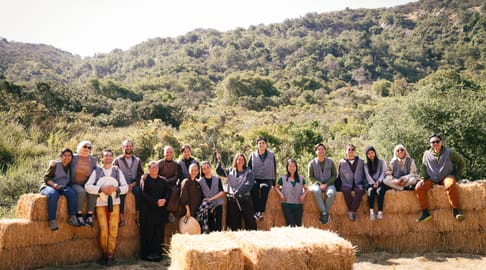Engaged Buddhism
Embodying the teachings of the Buddha in every moment, transforming suffering and nurturing peace through mindful action, deep looking, and compassion.

Embodying the teachings of the Buddha in every moment, transforming suffering and nurturing peace through mindful action, deep looking, and compassion.


Turn Your Inbox into a Dharma Door
Subscribe to our Coyote Tracks newsletter on Substack to receive event announcements, writing, art, music, and meditations from Deer Park monastics.
Support Deer Park
Donations are our main source of support, so every offering is greatly appreciated. Your contribution helps us to keep the monastery open to receive guests throughout the year.
DonateThe heart of Buddhism is awakening—seeing life clearly and understanding suffering, its causes, and the way to freedom. It is about touching life deeply, with presence and love. This freedom does not mean escaping life or turning away from the world. In touching this freedom, we are not affected by fear, forgetfulness, and despair. It is about having the courage to enter life with openness, understanding, and love.
A person who is free is not controlled by fear, ambition, or attachment. They live in the world, but they are not caught by it. Their presence brings peace, like a calm river flowing through a busy town. When we are around them, we feel lighter, more at ease, and more connected to life.
A person who has awakened carries the aspiration to be of service, to help others touch peace and freedom. If we become attached to results, we will suffer. If we act with an open heart, without clinging to success or failure, our service will bring peace.
A Bodhisattva is someone who walks this path—helping others while remaining free. They do not lose themselves in sorrow, even when facing suffering. They bring understanding and kindness without seeking praise or reward. Their way is both active and still, deeply engaged and deeply at peace.
The term Tiếp Hiện means receiving and realizing. To receive the Dharma means to open oneself to the deep wisdom of the Buddha’s teachings—not just as ideas, but as a living experience. To realize the Dharma means to bring it into life, to embody it in every thought, word, and action.
Tiếp Hiện members are those who bridge the deep practice of meditation and the everyday concerns of the world. They receive the life force of the Dharma from those who have gone deeply into the practice and bring it into realization through compassionate action. Their role is to help the wisdom of Buddhism become tangible and accessible, to nourish both the monastic and lay communities.
For this vision to become a reality, the Buddhist community must establish a strong foundation. There must be places of deep practice—monasteries where monastics can live simply and wholeheartedly, free from distractions. These centers must be well-supported, not through personal offerings, but through a collective commitment to providing the basic conditions for practice—food, shelter, medicine, and study materials.
Such monasteries must be places of peace, free from the demands of worldly concerns. The true purpose of these centers is to cultivate the depth of practice that will sustain the Tiếp Hiện order and provide a strong foundation for Buddhism in the world.
Buddhism does not need to be brought into life—it is already part of life. The question is not whether Buddhism can enter the world, but whether we can truly manifest it in our daily lives. If the Dharma is not alive in our way of living, then what remains is only its outer form—rituals, temples, ceremonies—without its true essence.
Engaged Buddhism is not merely activism. It is the natural flowering of deep practice. It is wisdom and compassion in action. It is the ability to sit in stillness and listen deeply, to walk mindfully, to speak with kindness, to take care of the suffering within and around us. It is
Those who dedicate themselves to deep practice provide the roots. Those who engage with the world bring forth the fruits. Both are needed. But the fruits cannot grow if the roots are not strong. That is why those who work in the world must regularly return to the monastery, to deepen their practice, to touch the source, and to renew their aspiration.
If even a few people embody the Dharma—living simply, deeply, and freely—the world will benefit greatly. Their presence will be like fresh water in a dry land, bringing peace and renewal without needing to say a word.
A true practitioner is not someone who seeks fame or performs miracles. They are quiet, steady, and essential—like light, like air. Their way of being helps others come home to themselves and live with authenticity.
We do not need to create enlightened beings. We only need to create the conditions for them to appear. If we establish places of deep practice, if we cultivate mindfulness, if we take care of our own hearts and minds, then wisdom and compassion will arise naturally.
Engaged Buddhism is not something outside of us. It is not something we have to build from scratch. It is already here, waiting for us to touch it. It is in the way we breathe, the way we walk, the way we care for one another. If we live mindfully, if we are present for life, then Buddhism is already engaged.
The path is clear. The way is open. All we need to do is take one mindful step.
From time to time we offer multi-week courses related to mindfulness, the teachings and life of Thich Nhat Hanh, and a variety of similar subjects. Please see our schedule of upcoming courses.

Take the Deer Park Monastery and Plum Village community with you wherever you go. The Plum Village app is designed to cultivate mindfulness, compassion, and joy through guided meditations, deep relaxations, practice poems, bells of mindfulness, and other practices — all through a mobile device.
